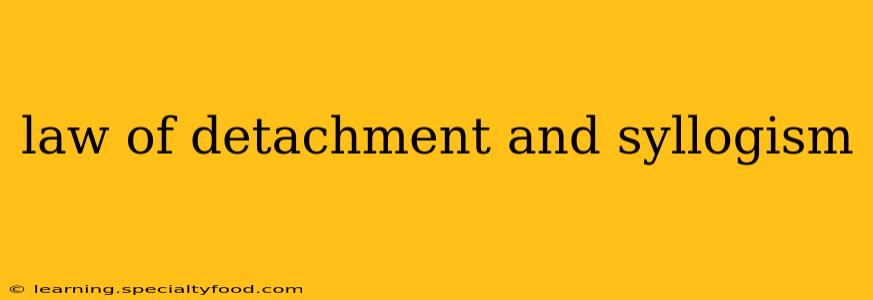The law of detachment and syllogism are fundamental principles in logic, forming the bedrock of deductive reasoning. Understanding these concepts is crucial for critical thinking, problem-solving, and effective communication. While seemingly simple, their applications are surprisingly widespread, impacting everything from mathematical proofs to everyday decision-making. This article will explore both concepts in detail, providing clear explanations and examples to illuminate their importance.
What is the Law of Detachment?
The law of detachment, also known as modus ponens, is a rule of inference that states:
If P, then Q. P. Therefore, Q.
This means if a conditional statement ("If P, then Q") is true, and the hypothesis (P) is also true, then the conclusion (Q) must also be true. Let's illustrate this with an example:
- If it is raining (P), then the ground is wet (Q).
- It is raining (P).
- Therefore, the ground is wet (Q).
This is a straightforward example. However, the law of detachment's power lies in its ability to deduce conclusions from more complex conditional statements.
What is a Syllogism?
A syllogism is a type of logical argument that consists of three parts:
- Major Premise: A general statement.
- Minor Premise: A specific statement related to the major premise.
- Conclusion: A statement logically derived from the two premises.
Syllogisms follow a specific structure, often using categorical propositions (statements that assert something about a category or class). The classic example is:
- Major Premise: All men are mortal.
- Minor Premise: Socrates is a man.
- Conclusion: Therefore, Socrates is mortal.
This demonstrates a deductive argument: if the premises are true, the conclusion must be true.
Types of Syllogisms
There are various types of syllogisms, categorized by the relationship between the terms (subject, predicate) in the premises and conclusion. Some common types include:
- Categorical Syllogisms: These use categorical propositions (all, some, no, etc.) to relate terms. The example above is a categorical syllogism.
- Hypothetical Syllogisms: These use conditional statements ("If...then...") as premises. The law of detachment is a specific form of hypothetical syllogism.
- Disjunctive Syllogisms: These use disjunctive premises (either...or...) to reach a conclusion.
How are the Law of Detachment and Syllogism Related?
The law of detachment can be considered a simplified form of a hypothetical syllogism. It focuses on a single conditional statement and its hypothesis, while syllogisms can incorporate more complex relationships between multiple statements. Essentially, the law of detachment is a tool used within the broader framework of syllogistic reasoning.
How can I identify a valid syllogism?
Identifying a valid syllogism requires careful examination of the premises and their relationship to the conclusion. Several techniques can help:
- Venn Diagrams: These visual aids can help visualize the relationships between sets and determine if the conclusion follows logically from the premises.
- Truth Tables: These tables can systematically evaluate the truth values of the premises and the conclusion to determine validity.
- Rules of Inference: Various rules of inference, including the law of detachment, can be applied to check the validity of syllogistic arguments.
What are some common fallacies in syllogistic reasoning?
Several errors can invalidate a syllogism:
- Undistributed Middle Term: The middle term (the term appearing in both premises but not the conclusion) must be distributed in at least one premise.
- Illicit Major/Minor: The major/minor term cannot be distributed in the conclusion unless it is distributed in the corresponding premise.
- Affirming the Consequent: This fallacy wrongly assumes that if Q is true, then P must also be true (in an "If P, then Q" statement).
- Denying the Antecedent: This fallacy wrongly assumes that if P is false, then Q must also be false.
Conclusion
The law of detachment and syllogism are essential tools for constructing and evaluating logical arguments. By understanding these principles, individuals can enhance their critical thinking skills, improve their reasoning abilities, and make more informed decisions. While seemingly simple in their basic forms, mastering their subtleties is crucial for navigating complex information and arguments in various aspects of life.
